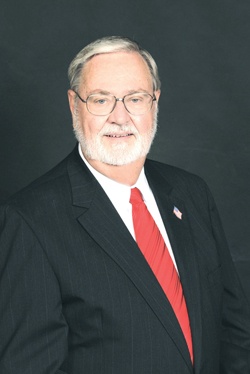Alliances Roadmap is Still Under Construction
by July 6, 2012 8:29 am 283 views

It seems fitting. The roadmap that will help strengthen a bond between Fort Smith and Fayetteville is still under construction.
City leaders from Fort Smith and Fayetteville announced in February an alliance as the two communities started to cement their economic development relationship. Official news conferences were held in both cities, with remarks from Fort Smith mayor Sandy Sanders and Fayetteville mayor Lioneld Jordan.
The gist from both men was that a conscientious effort would be made to plan for and pursue economic development endeavors to benefit both cities.
Fort Smith city administrator Ray Gosack called the announcement a breakthrough. This particular spin on the “sister city” concept, after all, was more likely to be seen between Northwest Arkansas cities Fayetteville and Springdale. Or Van Buren and Fort Smith in the River Valley.
“I think they just realized we could be much stronger and influential working together,” Gosack said.
Said Jordan: “I look at this region starting in Fort Smith and going through Bentonville and Bella Vista. Somebody asked me, ‘What difference is it going to make if Fort Smith is in the region?’ I said, ‘We put another chair at the table.’ You can put Van Buren in there, Alma in there. We’re all [one] region.
“I like what Mayor Sanders said. That [Bobby Hopper] tunnel is not something that separates Fort Smith from Fayetteville. It unites us.”
So what has been done to advance the momentum of those news conferences?
Initial conversations produced a formal meeting, held in March in Fort Smith. Between 75 and 100 leaders from multiple organizations gathered to discuss the most important area of interest to both areas — transportation.
The four topics were the completion of Interstate 49 — construction that would take the artery through Fort Smith and connect New Orleans with Canada — improving river transportation by channelization of the Arkansas River to 12-foot depth, enhancing railroad traffic and expanding air travel between both cities.
Working from a detailed agenda for nearly three hours, ideas were exchanged, thoughts were shared, numbers were crunched and brains were stormed.
It was a productive meeting, Sanders said.
“This is a great idea that Mayor Jordan initiated,” he said. “But we need to make sure we don’t fumble it. We need a game plan to do the things that we need to have done.
“We don’t need to have a meeting just to say we had a meeting.”
Helping put some action with that work session is the Institute for Economic Advancement at the University of Arkansas at Little Rock. The IEA was created in 1955 and, according to its website, “supports statewide economic development activities through research, information, service, training and education.”
Jim Youngquist, executive director of the IEA and an expert in economic development, offered the organization’s help upon hearing news of the alliance.
“When I saw that the mayors had decided to do this, I knew we needed to offer our assistance,” he said. “We’ve got a lot of expertise from people who have been involved in local and regional governance who can provide support to two already very competent entities.”
Youngquist said the organization’s major focus is on helping build and support public and private regional initiatives that will enhance both communities and regions.
It is the only university-based organization in Arkansas that has a statewide mission and mandate in economic development.
“In this day and age, you can’t live in a bubble,” he said. “You have to look at the bigger picture and how the world looks at that region. From an economic development standpoint, there are not many people in London or Paris or Shanghai or wherever who would separate Fayetteville from Fort Smith.”
The IEA will be a key player when Sanders and Jordan hold their second formal meeting in Fayetteville later this month. A specific date has not been determined.
There is no contract between the two groups, but the IEA will provide in-kind services because that is part of the organization’s mission, to support efforts such as this.
Youngquist said his role will not be to “dictate, overtake or staff” the work of the group.
“I feel like we will be able to help them move along,” he said. “Where we help is facilitation and helping design some operating procedures.”
The focus at the second meeting will be identifying other “big-picture” issues in addition to transportation.
“That is our next step, to get our roadmap planned,” Sanders said. “We want to have some true work plans, some targets and target dates, and [the IEA] can help us in setting those targets and what is the best way to proceed at this point. Rather than just say, ‘OK, what are we going to do next?’ let’s try to set some good working processes to get us where we need to be.”
